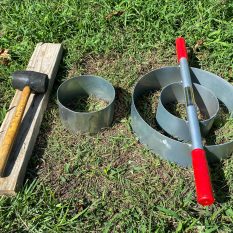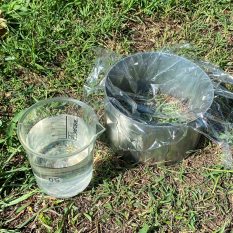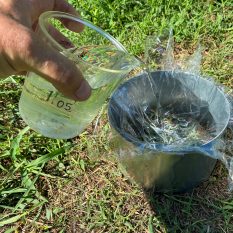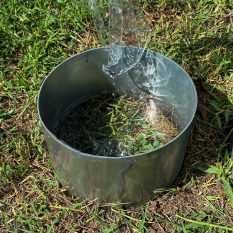Why is water infiltration important?
Here's how you can measure water infiltration in your own orchard.
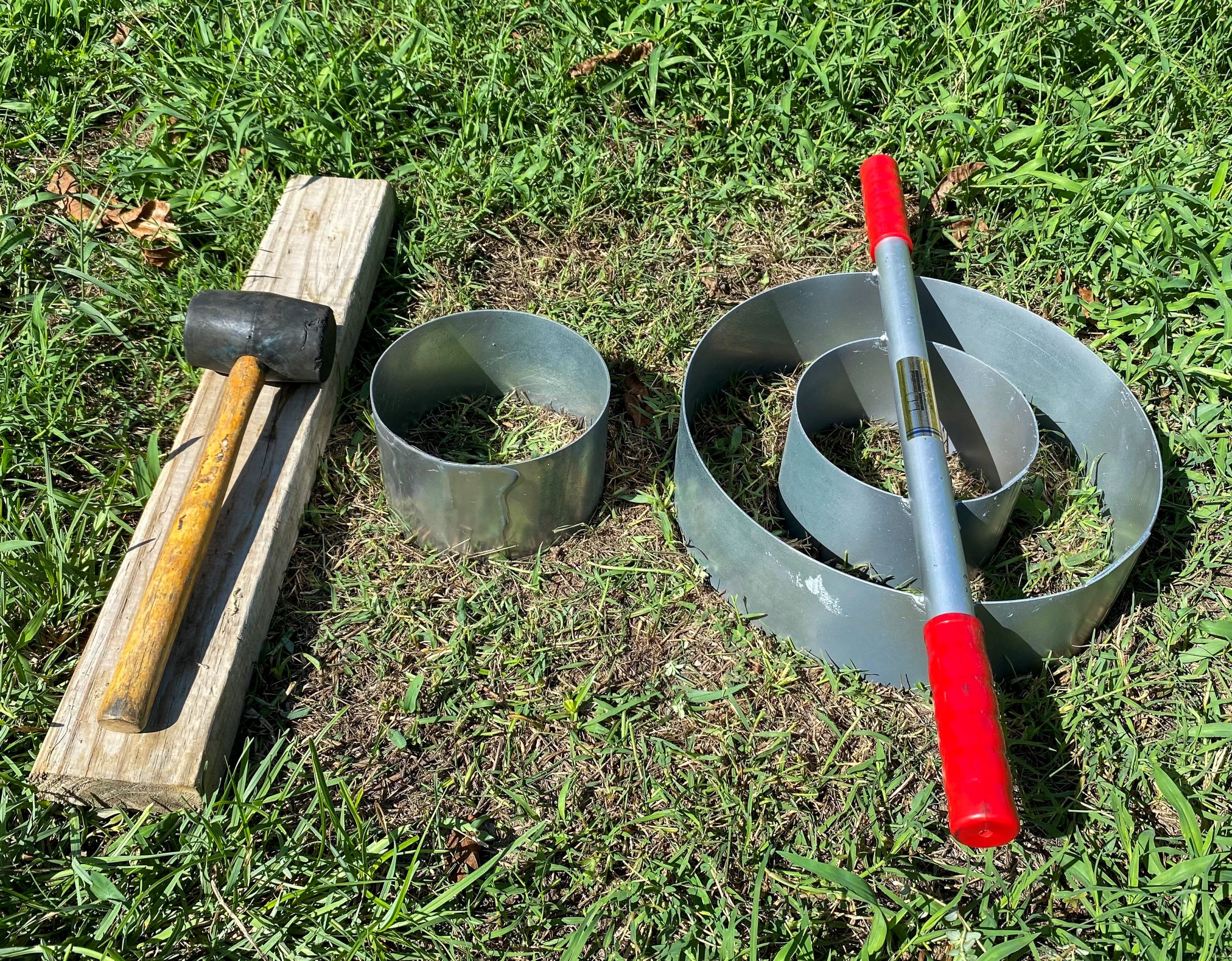
A board and rubber mallet are use to drive the single ring infiltrometer (left) or the double ring infiltrometer (right) into the soil. (Photo by Charlie Graham)
Whenever I am evaluating a prospective site for establishing a pecan orchard, it generally starts with the soil. Pecan trees are adaptable and will grow in many types of soils, but maximum growth occurs in deep, well-drained soils. Shallow soils with poor drainage or very sandy soils with low water-holding capacity are usually not good choices for commercial pecan production unless modifications are made and increased management is used. A quick review of the county soil survey document will give you general information on soil type, depth, basic fertility, drainage characteristics, slope, and other chemical and physical characteristics of the soil. But that will only take you so far. You really need to be hands-on to properly evaluate the site.
Water movement needs to be evaluated several different ways. Let’s start with surface drainage. Some potential sites adjacent to waterways may be classified as a wetland or have a high-water table, which may make them inappropriate for a commercial orchard. Sites with drainage issues (and not designated as a wetland by the USDA Natural Resources Conservation Service) may be made usable with some remediation (drainage tiles, cut drainage ditches, etc.). Contact the NRCS for help in developing a drainage plan for the location. Other surface water considerations would include, “Does the site flood?” If it does, what time of the year does the flooding occur? When it does flood, does the water recede quickly, or does the water pond on the site? The answers to those questions are important in determining the site’s suitability for a pecan orchard.
Not only do you need to evaluate the surface drainage but also the internal or sub-surface drainage of the soil. As discussed at many field days and meetings, an ideal soil is about 50% minerals and organic matter, 25% air, and 25% water. Soil saturated with water will be deficient in oxygen, adversely affecting root growth. So existing trees at the site may have limb dieback, a thin or open canopy, and overall stunted growth. An easy test for internal drainage when the soil is at field capacity is to dig a 32-inch-deep hole with a posthole digger. Fill the hole with water (about 7 gallons) and evaluate how long it takes the water to drain. If the water is gone in 24 hours, you have excellent internal drainage. If it takes 48 hours to drain, your drainage is adequate for growing pecans. If water remains in the hole after 48 hours, you can expect some reduction in production unless steps are taken to improve soil drainage. The poor drainage may be due to a high-water table, and this possibility should be investigated. The water table should be at least 6 feet below the soil surface to provide an adequate rooting area.
As many of you know, Noble Research Institute has launched an initiative promoting soil health to improve orchard profitability. It has involved evaluating several soil parameters to monitor soil performance. One of the tests we commonly use to assess soil health is water infiltration.
Let’s start by defining water infiltration, which is the downward entry of water into a soil with its velocity measured in inches per hour. So, why do we consider it important? With many areas of the Midwest being in severe drought, you want to take advantage of any rainfall that may come your way. For example, what if you received a 2-inch rain tomorrow, but the rain intensity exceeded your soil’s infiltration capacity, and only half of it infiltrated the soil with the rest being lost as runoff. An acre inch of water equals 27,154 gallons of water, so at a 40-by-40 feet tree spacing (27 trees per acre), you just lost over 1,000 gallons of water per tree. Simply put, for rain or irrigation water to have value, it must enter the soil—not run off.
Before we discuss the technique of measuring water infiltration, we should first discuss what factors influence infiltration in an orchard. The most obvious is the texture of your soil. The finer the soil particle, the smaller the pore size, and the slower the infiltration rate. An exception would be measuring water infiltration on a dry, heavy clay. Dense clays with a high shrink/swell capacity develop large cracks as the soil dries, leading to an overestimation of the infiltration capacity.
This leads us to the next factor affecting infiltration: soil moisture content. Soils should be at field capacity (following a rain or irrigation event) to improve the accuracy of the test. Dry soils will overestimate, and saturated soils will underestimate the infiltration capacity. Following a controlled burn or wildfire event, the soil surface can develop a hydrophobicity due to hot air dispersing waxy compounds from the surface litter into the soil. This condition can severely reduce the infiltration rate of a soil.
Another important factor impacting water infiltration of a soil is organic matter content. Using management techniques to increase the organic matter content of an orchard soil results in improved aggregation and soil structure, increasing the water infiltration capacity. Organic matter from sources such as livestock grazing, organic fertilizers, mulches, and cover crops will improve infiltration and water holding capacity so that more rain or irrigation water can get into the soil, be held, and remain available for tree roots over a longer period of time. If the infiltration rate is too slow, it can result in ponding in level areas, surface runoff, and erosion in sloping areas, and it can lead to flooding or inadequate moisture for crop production. An overarching goal in the orchard is to minimize soil disturbance and compaction, protect soil from erosion, and encourage the development of good soil structure and continuous pore space.
Commonly used direct methods for measuring soil infiltration include single ring and double ring infiltrometers, Mariotte double ring infiltrometer, disc permeameter, rainfall simulator, runoff-on-ponding, runoff-on-out, and linear source methods. For our purposes, a simple and relatively accurate choice is the single ring infiltrometer method. Generally, a metal ring is hammered into the ground, a known quantity of water is added to the ring, and the rate the water moves into the soil is quantified. Although it is simple to use and easy to interpret, the single ring infiltrometer method does have disadvantages compared to the double ring method. Double ring infiltrometers minimize the error arising from the water’s lateral flow due to three-dimensional flow conditions compared to the single ring method, thereby making them more reliable.
Multidimensional water flow under the single ring can be reduced by pushing the ring deeper into the soil. Double ring infiltrometers are commonly fitted with a 6-inch inner ring and 12-inch outer ring, and are more expensive to purchase. Both single and double ring infiltrometer methods can utilize a falling or constant head when measuring infiltration. A falling head test involves adding a known quantity of water and measuring the time required for it to move into the soil. In contrast, a constant head test is when we measure the quantity of water necessary to maintain the water at a uniform level in the cylinder. While the falling head test is easier to employ, it is less accurate on some soil types. Infiltration rates on coarse soils will often be underestimated using the falling head test, while there are typically minimal differences between falling and constant head tests on fine textured soils.
Some closing comments concerning multidimensional water flow under the single ring. It is understood that water will flow in a soil both horizontally and vertically, leading to greater infiltration values than if we could confine the water movement to strictly a downward, vertical path. While there are equations to correct for this variation, they are not necessary for year-to-year comparative purposes. We are assuming that a similar amount of water is moving multidimensionally for each test. Additionally, you should remember that water infiltration is highly dependent on soil structure, so any orchard management practices that degrade the soil’s structure will adversely affect infiltration. Monitoring infiltration rates under different soil management practices will provide a good reflection of how each practice will impact water movement through the soil.
Now, that you know the importance of water infiltration, here’s how you can do it in your orchard. First, you’ll need these materials to measure infiltration:
- piece of flat board or plank about 2 centimeters thick and long enough to span the diameter of the ring
- a 6-inch diameter single infiltration ring (Sharpen one edge of the ring (outside to inside) so that it is easier to push into the soil.)
- garden clippers
- rubber mallet
- plastic wrap
- measuring cup or graduated cylinder
- about 5 liters of rainwater or distilled water
- stopwatch or phone
- a recording sheet and pen
Next, you’ll follow these steps to determine the water infiltration rate of a soil.
- Locate your chosen sample site, within the row areas will generally have less compaction than the drive rows.
- Remove all debris, weeds, and vegetation where you aim to set the tube—either trim down with garden clippers or cut through with a knife. Clear all clipping residue from the soil surface.
- Use the rubber mallet and block of wood to drive the ring into the soil to a depth of 3 inches. Take care to drive the ring downward evenly and vertically.
- Firm soil gently on the inside of the tube. Gently tamp down the soil inside the ring to eliminate gaps. Cover the inside of the ring with plastic wrap to protect the soil when pouring water into the ring and drape it over the rim.
- Pour 15 ounces (444 mL) of distilled water or collected rainwater into the plastic-lined ring. This is equivalent to 1 inch of water in a 6-inch diameter cylinder.
- After pouring water into the cylinder, gently pull away the plastic sheet and start the timer. Stop thetimer when the cylinder is empty and the soil surface is “glistening” with moisture. Record the time necessary for the water to infiltrate the soil.
- Repeat steps 4-6 (several measurements may be necessary) to determine the steady-state infiltration rate. Generally, the second test is used as the first test wet the soil. If the soil is already wet following an irrigation or rainfall event, there may be only slight differences between the two test times. Use this equation to calculate the rate: Infiltration inches/hour = 60/minutes taken to infiltrate 1 inch or 25mm. For example, 10 minutes to infiltrate 1 inch would be 6.0 inches/hour (60 / 10).

